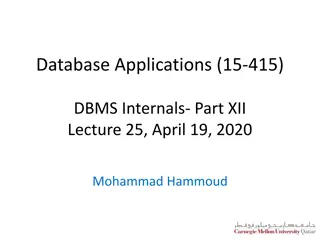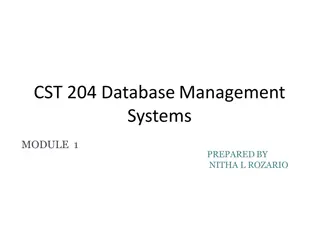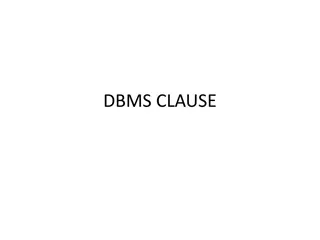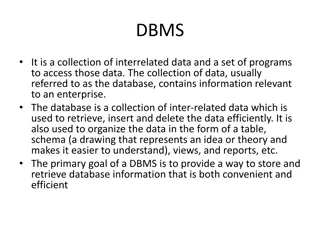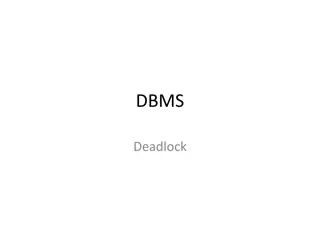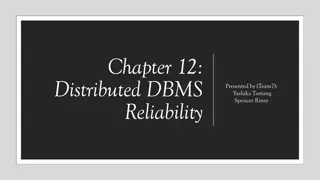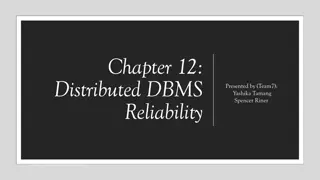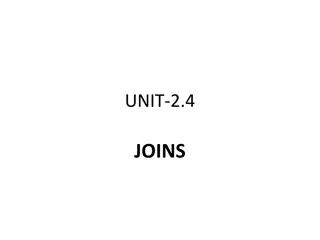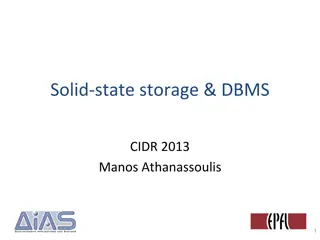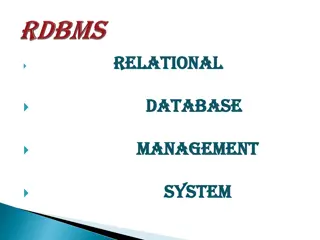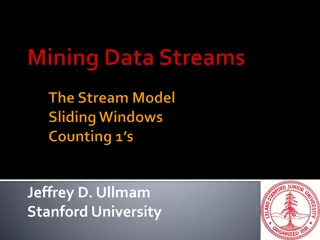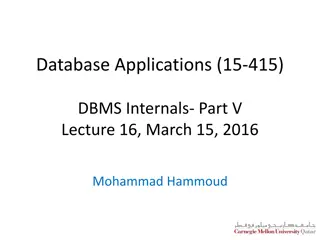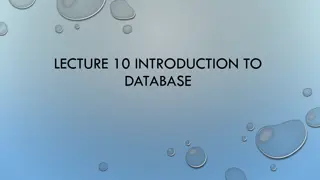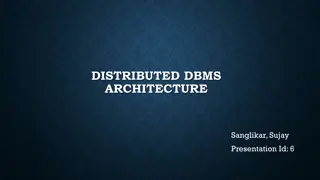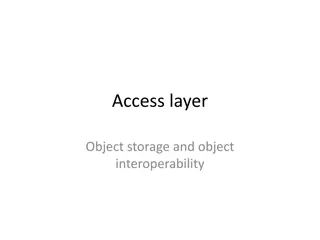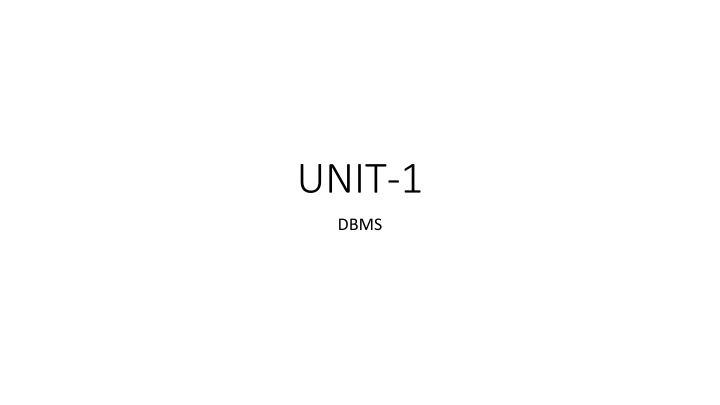
Data Management Systems for Effective Information Handling
Explore the concept of data and databases in the realm of Information Technology. Learn about centralized and distributed databases, their advantages, disadvantages, and types like relational databases. Delve into the world of data organization and efficient management techniques.
Download Presentation

Please find below an Image/Link to download the presentation.
The content on the website is provided AS IS for your information and personal use only. It may not be sold, licensed, or shared on other websites without obtaining consent from the author. If you encounter any issues during the download, it is possible that the publisher has removed the file from their server.
You are allowed to download the files provided on this website for personal or commercial use, subject to the condition that they are used lawfully. All files are the property of their respective owners.
The content on the website is provided AS IS for your information and personal use only. It may not be sold, licensed, or shared on other websites without obtaining consent from the author.
E N D
Presentation Transcript
UNIT-1 DBMS
What is Data? Data is a collection of a distinct small unit of information. It can be used in a variety of forms like text, numbers, media, bytes, etc. it can be stored in pieces of paper or electronic memory, etc. Word 'Data' is originated from the word 'datum' that means 'single piece of information.' It is plural of the word datum. In computing, Data is information that can be translated into a form for efficient movement and processing. Data is interchangeable. What is Database? A database is an organized collection of data, so that it can be easily accessed and managed. Types of Databases There are various types of databases used for storing different varieties of data:
1) Centralized Database It is the type of database that stores data at a centralized database system. It comforts the users to access the stored data from different locations through several applications. These applications contain the authentication process to let users access data securely. An example of a Centralized database can be Central Library that carries a central database of each library in a college/university. Advantages of Centralized Database It has decreased the risk of data management, i.e., manipulation of data will not affect the core data. Data consistency is maintained as it manages data in a central repository. It provides better data quality, which enables organizations to establish data standards. It is less costly because fewer vendors are required to handle the data sets. Disadvantages of Centralized Database The size of the centralized database is large, which increases the response time for fetching the data. It is not easy to update such an extensive database system. If any server failure occurs, entire data will be lost, which could be a huge loss. 2) Distributed Database Unlike a centralized database system, in distributed systems, data is distributed among different database systems of an organization. These database systems are connected via communication links. Such links help the end-users to access the data easily. Examples of the Distributed database are Apache Cassandra, HBase, Ignite, etc. We can further divide a distributed database system into:
Homogeneous DDB: Those database systems which execute on the same operating system and use the same application process and carry the same hardware devices. Heterogeneous DDB: Those database systems which execute on different operating systems under different application procedures, and carries different hardware devices. Advantages of Distributed Database Modular development is possible in a distributed database, i.e., the system can be expanded by including new computers and connecting them to the distributed system. One server failure will not affect the entire data set.
3) Relational Database This database is based on the relational data model, which stores data in the form of rows(tuple) and columns(attributes), and together forms a table(relation). A relational database uses SQL for storing, manipulating, as well as maintaining the data. E.F. Codd invented the database in 1970. Each table in the database carries a key that makes the data unique from others. Examples of Relational databases are MySQL, Microsoft SQL Server, Oracle, etc. Properties of Relational Database There are following four commonly known properties of a relational model known as ACID properties, where: A means Atomicity: This ensures the data operation will complete either with success or with failure. It follows the 'all or nothing' strategy. For example, a transaction will either be committed or will abort. C means Consistency: If we perform any operation over the data, its value before and after the operation should be preserved. For example, the account balance before and after the transaction should be correct, i.e., it should remain conserved. I means Isolation: There can be concurrent users for accessing data at the same time from the database. Thus, isolation between the data should remain isolated. For example, when multiple transactions occur at the same time, one transaction effects should not be visible to the other transactions in the database. D means Durability: It ensures that once it completes the operation and commits the data, data changes should remain permanent.
4) NoSQL Database Non-SQL/Not Only SQL is a type of database that is used for storing a wide range of data sets. It is not a relational database as it stores data not only in tabular form but in several different ways. It came into existence when the demand for building modern applications increased. Thus, NoSQL presented a wide variety of database technologies in response to the demands. We can further divide a NoSQL database into the following four types: 1.Key-value storage: It is the simplest type of database storage where it stores every single item as a key (or attribute name) holding its value, together. 2.Document-oriented Database: A type of database used to store data as JSON-like document. It helps developers in storing data by using the same document-model format as used in the application code. 3.Graph Databases: It is used for storing vast amounts of data in a graph-like structure. Most commonly, social networking websites use the graph database. 4.Wide-column stores: It is similar to the data represented in relational databases. Here, data is stored in large columns together, instead of storing in rows.
Advantages of NoSQL Database It enables good productivity in the application development as it is not required to store data in a structured format. It is a better option for managing and handling large data sets. It provides high scalability. Users can quickly access data from the database through key-value. 5) Cloud Database A type of database where data is stored in a virtual environment and executes over the cloud computing platform. It provides users with various cloud computing services (SaaS, PaaS, IaaS, etc.) for accessing the database. There are numerous cloud platforms, but the best options are: Amazon Web Services(AWS) Microsoft Azure Kamatera PhonixNAP ScienceSoft Google Cloud SQL, etc. 6) Object-oriented Databases The type of database that uses the object-based data model approach for storing data in the database system. The data is represented and stored as objects which are similar to the objects used in the object-oriented programming language.
7) Hierarchical Databases It is the type of database that stores data in the form of parent-children relationship nodes. Here, it organizes data in a tree-like structure. Data get stored in the form of records that are connected via links. Each child record in the tree will contain only one parent. On the other hand, each parent record can have multiple child records. 8) Network Databases It is the database that typically follows the network data model. Here, the representation of data is in the form of nodes connected via links between them. Unlike the hierarchical database, it allows each record to have multiple children and parent nodes to form a generalized graph structure. 9) Personal Database Collecting and storing data on the user's system defines a Personal Database. This database is basically designed for a single user.
Advantage of Personal Database It is simple and easy to handle. It occupies less storage space as it is small in size. 10) Operational Database The type of database which creates and updates the database in real-time. It is basically designed for executing and handling the daily data operations in several businesses. For example, An organization uses operational databases for managing per day transactions. 11) Enterprise Database Large organizations or enterprises use this database for managing a massive amount of data. It helps organizations to increase and improve their efficiency. Such a database allows simultaneous access to users. Advantages of Enterprise Database: Multi processes are supportable over the Enterprise database. It allows executing parallel queries on the system.
What is RDBMS RDBMS stands for Relational Database Management Systems.. All modern database management systems like SQL, MS SQL Server, IBM DB2, ORACLE, My-SQL and Microsoft Access are based on RDBMS. It is called Relational Data Base Management System (RDBMS) because it is based on relational model introduced by E.F. Codd. How it works Data is represented in terms of tuples (rows) in RDBMS. Relational database is most commonly used database. It contains number of tables and each table has its own primary key. Due to a collection of organized set of tables, data can be accessed easily in RDBMS. Brief History of RDBMS During 1970 to 1972, E.F. Codd published a paper to propose the use of relational database model. RDBMS is originally based on that E.F. Codd's relational model invention. What is table The RDBMS database uses tables to store data. A table is a collection of related data entries and contains rows and columns to store data. A table is the simplest example of data storage in RDBMS. Let's see the example of student table.
ID Name AGE COURSE 1 Ajeet 24 B.Tech 2 aryan 20 C.A 3 Mahesh 21 BCA 4 Ratan 22 MCA 5 Vimal 26 BSC What is field Field is a smaller entity of the table which contains specific information about every record in the table. In the above example, the field in the student table consist of id, name, age, course. What is row or record A row of a table is also called record. It contains the specific information of each individual entry in the table. It is a horizontal entity in the table. For example: The above table contains 5 records. Let's see one record/row in the table. 1 Ajeet 24 B.Tech
What is column A column is a vertical entity in the table which contains all information associated with a specific field in a table. For example: "name" is a column in the above table which contains all information about student's name. Ajeet Aryan Mahesh Ratan Vimal NULL Values The NULL value of the table specifies that the field has been left blank during record creation. It is totally different from the value filled with zero or a field that contains space. Data Integrity There are the following categories of data integrity exist with each RDBMS: Entity integrity: It specifies that there should be no duplicate rows in a table. Domain integrity: It enforces valid entries for a given column by restricting the type, the format, or the range of values. Referential integrity: It specifies that rows cannot be deleted, which are used by other records. User-defined integrity: It enforces some specific business rules that are defined by users. These rules are different from entity, domain or referential integrity.
Difference between DBMS and RDBMS Although DBMS and RDBMS both are used to store information in physical database but there are some remarkable differences between them. The main differences between DBMS and RDBMS are given below: No. DBMS RDBMS 1) DBMS applications store data as file. RDBMS applications store data in a tabular form. 2) In DBMS, data is generally stored in either a hierarchical form or a navigational form. In RDBMS, the tables have an identifier called primary key and the data values are stored in the form of tables. 3) Normalization is not present in DBMS. Normalization is present in RDBMS. 4) DBMS does not apply any security with regards to data manipulation. RDBMS defines the integrity constraint for the purpose of ACID (Atomocity, Consistency, Isolation and Durability) property. 5) DBMS uses file system to store data, so there will be no relation between the tables. in RDBMS, data values are stored in the form of tables, so a relationship between these data values will be stored in the form of a table as well. 6) DBMS has to provide some uniform methods to access the stored information. RDBMS system supports a tabular structure of the data and a relationship between them to access the stored information. 7) DBMS does not support distributed database. RDBMS supports distributed database. 8) DBMS is meant to be for small organization and deal with small data. it supports single user. RDBMS is designed to handle large amount of data. it supports multiple users. 9) Examples of DBMS are file systems, xml etc. Example of RDBMS are mysql, postgre, sql server, oracle etc.
DBMS vs. File System There are following differences between DBMS and File system: DBMS File System DBMS is a collection of data. In DBMS, the user is not required to write the procedures. File system is a collection of data. In this system, the user has to write the procedures for managing the database. DBMS gives an abstract view of data that hides the details. File system provides the detail of the data representation and storage of data. DBMS provides a crash recovery mechanism, i.e., DBMS protects the user from the system failure. File system doesn't have a crash mechanism, i.e., if the system crashes while entering some data, then the content of the file will lost. DBMS provides a good protection mechanism. It is very difficult to protect a file under the file system. DBMS contains a wide variety of sophisticated techniques to store and retrieve the data. File system can't efficiently store and retrieve the data. DBMS takes care of Concurrent access of data using some form of locking. In the File system, concurrent access has many problems like redirecting the file while other deleting some information or updating some information.

